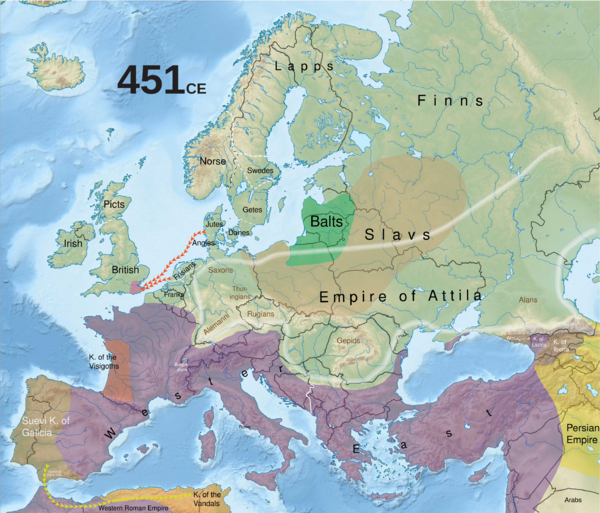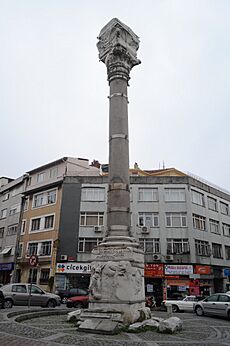Marcian facts for kids
Quick facts for kids Marcian |
|||||
|---|---|---|---|---|---|
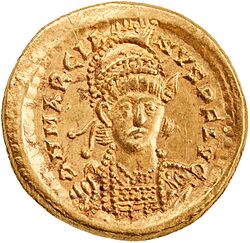
Solidus of Marcian
|
|||||
| Roman emperor in the East | |||||
| Reign | 25 August 450 – 27 January 457 | ||||
| Predecessor | Theodosius II | ||||
| Successor | Leo I | ||||
| Western emperors |
Valentinian III (450–455) Petronius Maximus (455) Avitus (455–456) |
||||
| Born | c. 392 Thrace or Illyria |
||||
| Died | 27 January 457 (aged 65) Constantinople (now Istanbul, Turkey) |
||||
| Burial | Church of the Holy Apostles | ||||
| Spouse | |||||
| Issue | Marcia Euphemia | ||||
|
|||||
| Dynasty | Theodosian | ||||
| Religion | Chalcedonian Christianity | ||||
| Emperor Marcian | |
|---|---|
| The Holy and right believing emperor of Romans Marcian | |
| Honored in | Eastern Orthodox Church |
| Feast | 17 February |
| Attributes | Imperial attire |
| Major works | Convened the Council of Chalcedon |
Marcian (born around 392 – died January 27, 457) was a powerful Roman emperor who ruled the Eastern Roman Empire from 450 to 457. Before he became emperor, Marcian was a personal assistant (called a domesticus) to important military commanders, including Aspar.
After Emperor Theodosius II died in 450, Aspar, who had a lot of military power, helped Marcian become a candidate for the throne. Theodosius's sister, Pulcheria, agreed to marry Marcian. This marriage helped make Marcian's rule seem more legitimate. Marcian became emperor on August 25, 450.
As emperor, Marcian made big changes. He stopped paying tribute to the Huns and their leader, Attila. He also held an important church meeting called the Council of Chalcedon. This council decided that Jesus had two natures: both divine and human. Marcian died in 457, leaving the Eastern Roman Empire with a lot of money in its treasury. This was a great achievement, especially since the Huns had caused so much economic trouble before his rule.
Contents
Early Life and Military Career
Marcian was born around 392 in either Thrace or Illyria. Ancient writers say he was tall and had a problem with his foot. We don't know much about his early life.
His father was a soldier, and Marcian joined the army when he was young. By 421, he was likely a military officer called a tribune. He became a personal assistant (domesticus) to Aspar, who was the main commander of the Eastern Roman army. Aspar was very influential in the empire.
In the early 430s, Marcian served under Aspar in Roman Africa. He was captured by the Vandals during this time. Some stories say that the Vandal king, Gaiseric, predicted Marcian would become emperor one day. After his capture, Marcian is not mentioned again until Theodosius II died.
Challenges Before Marcian's Rule
Theodosius II's Reign and the Huns
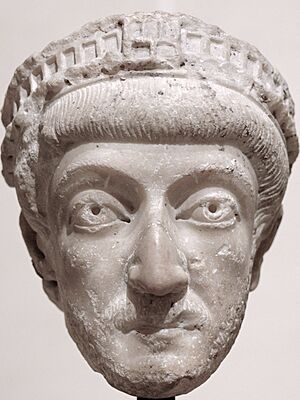
The Eastern Roman Empire faced many threats during the rule of Theodosius II. The Vandals started taking over Roman Africa in 429. Theodosius sent armies to stop them.
At the same time, the Huns, led by Attila, demanded money from the empire. Theodosius agreed to pay them a large amount of gold each year. The Huns kept increasing their demands, and Theodosius kept paying because he was worried about his empire's safety. He even brought soldiers back from Africa to protect against the Huns.
In 439, the Vandals captured the important city of Carthage. Both the Eastern and Western Roman Empires planned a huge attack to get it back. But in 442, the Huns attacked again after a Roman bishop raided their land. Attila captured and destroyed several cities. Theodosius had to recall his main commander, Aspar, and his army. After a big defeat, Theodosius agreed to pay the Huns tribute every year until he died in 450.
How Marcian Became Emperor
When Theodosius II died suddenly in a riding accident on July 28, 450, there was no clear successor. This caused a problem for the empire. Some stories say Theodosius named Marcian as his successor, but this was probably made up by Marcian's supporters later.
Marcian had served Aspar for 15 years. Aspar worked to get Marcian elected, even though Marcian wasn't very well known. After about a month of talks, Pulcheria, Theodosius II's sister, agreed to marry Marcian. Pulcheria was from the Theodosian dynasty, a family with strong ties to the throne. Her marriage to Marcian helped make his rule legitimate. Pulcheria had promised to remain a virgin, and she kept this promise during her marriage to Marcian.
Another powerful military leader, Flavius Zeno, also supported Marcian. Zeno was given a high rank, which suggests he was rewarded for his support. Marcian became emperor on August 25, 450. He immediately changed many of the old policies. He took a tougher stand against the Huns and became more involved in church matters.
Marcian's Rule and Major Policies
Dealing with the Huns
Right after becoming emperor, Marcian stopped paying the Huns. He told Attila that he would only give gifts if Attila was friendly. If Attila tried to attack, he would be stopped.
Attila was angry but was already planning to invade the Western Roman Empire. In 451, Attila led his army into Western Europe. He fought a huge battle called the Battle of the Catalaunian Plains. It involved about 100,000 soldiers and had many losses on both sides. Attila then retreated.
In 452, Attila invaded Roman Italy. He captured and looted important cities like Aquileia and Mediolanum (Milan). People feared he would attack Rome. However, Attila was running out of money and his army was tired. Also, Marcian's Eastern Roman army attacked the Huns' homeland across the Danube river. This attack, along with a famine and plague in Italy, made Attila retreat.
Attila died in 453. After his death, the Hunnic empire quickly broke apart. Marcian took advantage of this by allowing Germanic tribes to settle in Roman lands. These tribes, called foederati, provided military service in exchange for benefits. This helped the Eastern Empire keep peace and control its borders. Marcian also won small battles against other groups in Syria and Egypt.
Religious Changes

In the 5th century, there was a big debate about how the human and divine natures of Jesus Christ were connected. Different church groups had different ideas.
In 449, a meeting called the Second Council of Ephesus decided that Jesus had one united divine nature. But the Pope and the Patriarch of Constantinople disagreed, calling this idea a heresy.
To fix this, Marcian called a new church meeting in 451, the Council of Chalcedon. This council met in October 451. About 500 bishops attended. The council decided that Jesus had both a divine nature and a human nature, united in one person. This decision became the official view of the church.
The council also said that the church in Constantinople was very important, second only to the church in Rome. Marcian issued laws to support the council's decisions. These laws ordered that people who disagreed with the council's views would lose their jobs and their writings would be burned.
These decisions caused problems in the eastern parts of the empire, like Syria and Egypt. Many people there disagreed with the council. This led to protests and even violent revolts, which Marcian's army had to put down. This disagreement caused long-lasting problems and eventually led to some Christian groups separating from the main church.
Marcian also supported his wife Pulcheria's building projects. She focused on building religious buildings, like the Church of St. Mary of Blachernae.
Economy and Laws
When Marcian became emperor, the empire's treasury was almost empty because of the huge payments to Attila. Marcian fixed this by cutting spending, not by raising new taxes. He even canceled all debts owed to the state.
Marcian also made new laws to improve how the government worked. He tried to reduce corruption and abuses of power. For example, he made sure that only important senators living in Constantinople could hold certain public offices. He also made sure that city officials were responsible for maintaining Constantinople's water systems.
He removed some old laws, like a tax on senators' property. He also changed a law that prevented senators from marrying women of lower social status. Marcian said that a man could marry a woman of good character, no matter her social status or wealth.
By the time he died, Marcian's smart spending cuts and avoidance of big wars left the Eastern Roman treasury with a huge amount of gold. In 451, Marcian also made a law that anyone practicing pagan rituals would lose their property and face death. He ordered that no pagan temples could be reopened.
Relations with Western Roman Empire
Marcian became emperor without asking the Western Roman Emperor, Valentinian III. This showed how much the Eastern and Western Roman Empires were growing apart. Valentinian eventually recognized Marcian as emperor.
When the Vandals attacked and looted Rome in 455, Marcian did not respond with military force. He only sent a message demanding that the Vandals return the empress and her daughters. There's a story that Marcian, when he was captured by Vandals as a young man, promised their king, Gaiseric, that he wouldn't attack them if he became emperor. This story might have been made up to explain why Marcian didn't attack the Vandals.
Marcian tried several times to get the empress and her daughters back. He finally started planning an invasion of Vandal territory just before he died.
Death and Legacy
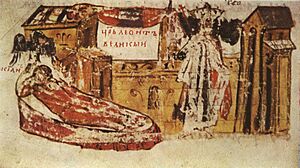
Marcian died on January 27, 457, at the age of 65. Some sources say he died after a long religious walk, which was hard for him because of a severe foot problem. He was buried in the Church of the Holy Apostles in Constantinople, next to his wife Pulcheria.
Marcian left the Eastern Empire with a lot of money in its treasury. This was a great achievement, especially after the Huns had caused so much economic damage.
Even though Marcian had a son-in-law, Anthemius, he didn't have a direct family connection to the old ruling family. So, Aspar once again helped choose the next emperor. He chose Leo I, a military officer.
Later, Leo sent Anthemius to become the Western Roman Emperor.
Marcian's Lasting Impact
Marcian was highly respected by later writers in the Eastern Roman Empire. They often compared him to famous emperors like Constantine I and Theodosius I. Many saw Marcian's rule as a "golden age." He made the Eastern Empire strong both politically and financially. He also set a clear religious direction that future emperors would follow.
Some historians say his success was also due to good luck. The two biggest threats to Rome, the Sassanian Empire and the Huns, were busy with their own problems during his reign. Also, there were no major natural disasters or plagues.
The people of Constantinople remembered him fondly. They would even shout "Reign like Marcian!" when new emperors were crowned. A column dedicated to Marcian still stands in Istanbul today.
Images for kids
-
A detail of the Missorium of Aspar, depicting Aspar and his elder son Ardabur (c. 434).


